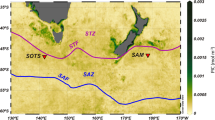Abstract
Strong seasonal signals in fluxes and composition of siliceous microfossils have been recorded in sediment traps from two sites in the equatorial Pacific, deployed from December 1982 to March 1984. During the early part of the sampling period, the 1982–83 El Niño event had a profound effect on the radiolaria and silico-flagellates within these two areas. During the El Niño, the radio-larian trap assemblages at Site C (1° N, 139° W) most resembled faunal assemblages in western equatorial Pacific sediments, whereas the trap assemblages resembled equatorial divergence sediments in the latter half of the period. At Site S (11° N, 140° W), the radiolaria and silicoflagellate species can be correlated with organic carbon fluxes. In general, silicoflagellate shell fluxes are correlated to total opal fluxes where radiolarian fluxes do not exhibit this relationship. Approximately 20–25% of the total count of radiolaria in traps are not present in underlying sediments with a significant loss of the weakly silicified forms. However, the comparison of trap sample assemblages with underlying sediments reported here shows that dissolution does not alter relative abundances of the fossil species used in palaeoclimatic reconstructions. A significant difference is observed between the silicoflagellate trap assemblage and the underlying sediment assemblage.
This is a preview of subscription content, access via your institution
Access options
Subscribe to this journal
Receive 51 print issues and online access
$199.00 per year
only $3.90 per issue
Buy this article
- Purchase on Springer Link
- Instant access to full article PDF
Prices may be subject to local taxes which are calculated during checkout
Similar content being viewed by others
References
Moser, J. C. et al. Limnol Oceanogr. (in the press).
Roelofs, A. & Pisias, N. Micropaleontology (in the press).
Takahashi, K. Mar. Micropaleontol. 8, 171–182 (1983/84); thesis MIT/Woods Hole Oceano-graphic Institution (1981).
Dymond, J. & Collier, R. Nature (in the press).
Moore, T. C. Jr Mar. Micropaleontol. 3, 229–266 (1978).
Lombari, G. & Boden, G. Cushman Foundation Spec. Publ. No. 16A–125 (1985).
Cande, M. Science 222, 1189–1195 (1983).
Ramusson, E. & Wallace, J. Science 222, 1195–1202 (1983).
Barber, R. & Chavez, F. Science 222, 1203–1210 (1983).
Takahashi, K. Geol. Soc. Am. Abstr. Prog. 16, 673 (1984).
Poelchau, H. Micropaleontology 22, 164–193 (1976).
Ling, S. & Takahashi, K. Micropaleontology 31, 76–81 (1979).
Murray, D. & Schrader, H. Mar. Micropaleontol. 7, 517–539 (1982).
Schrader, H. & Baumgartner, T. Coastal Upwelling (eds Theide, J. & Suess, E.). Part B, 247 (Plenum, New York, 1983).
Takahashi, K. & Honjo, S. Deep Sea Res. 30, 543–568 (1983).
Pisias, N. Mar. Micropaleontol. (in the press).
Moore, T. C. et al. Mar. Micropaleontol. 5, 215–248 (1979).
Author information
Authors and Affiliations
Rights and permissions
About this article
Cite this article
Pisias, N., Murray, D. & Roelofs, A. Radiolarian and silicoflagellate response to oceanographic changes associated with the 1983 El Niño. Nature 320, 259–262 (1986). https://doi.org/10.1038/320259a0
Received:
Accepted:
Issue Date:
DOI: https://doi.org/10.1038/320259a0
This article is cited by
-
Sinking Particle Flux in the Subtropical Oligotrophic Northwestern Pacific from a Short-term Sediment Trap Experiment
Ocean Science Journal (2018)
-
Siliceous microplankton fluxes and seasonal variations in the central South China Sea during 1993–1995: monsoon climate and El Niño responses
Chinese Science Bulletin (2000)
Comments
By submitting a comment you agree to abide by our Terms and Community Guidelines. If you find something abusive or that does not comply with our terms or guidelines please flag it as inappropriate.



